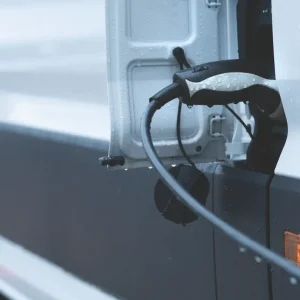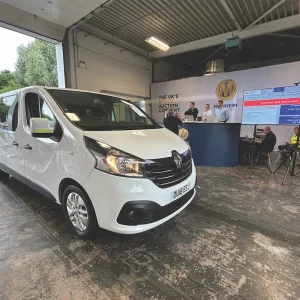Nor should Boxer be ignored. While a van of its size is in danger of being steamrollered flat in the UK market by Ford’s all-conquering Transit, it’s not without advantages. Like so much of the rest of the Peugeot range Boxer is of course one of the fruits of a long-standing joint venture between PSA, Peugeot and Citroën’s parent company, and Fiat. Boxer, Citroën’s Relay and Fiat’s Ducato all share the same basic design.
Technical
Boxer is marketed in a variety of different configurations — as a van, a window van, a chassis cab and with a crew cab — and with three different diesels. You can pick from a 2.2-litre HDi at either 100hp or 120hp or a 3.0-litre HDi pumping out a generous 157hp.
The medium-wheelbase (3,450mm) standard roof van we elected to test was equipped with the beefiest 2.2-litre. Maximum power kicks in at 3,500rpm while peak torque of 320Nm bites at 2,000rpm and the four-cylinder engine is married to a six-speed manual gearbox.
You’ll find independent suspension with MacPherson-type struts at the front and longitudinal leaf springs at the back. Our demonstrator sat on 15in steel wheels shod with Continental Vanco 215/70 R15C tyres.
Disc brakes are fitted all round — ventilated at the front — with ABS, Electronic Brake Force Distribution and Emergency Brake Assist as standard. Electronic Stability Programme is not a standard feature, alas. Power-assisted rack-and-pinion steering is fitted with 3.9 turns lock-to-lock.
Grossing at 3.3 tonnes, our Boxer could handle a 1,400kg gross payload and tow a braked trailer with an all-up weight of 2,500kg. Peugeot’s biggest light commercial is also marketed at gross weights of 3.0 and 3.5 tonnes; it does not market Boxers at higher gross weights in the UK.
Load Area
 Swinging open the twin, unglazed, rear doors of our test van revealed a 10m3 load box — Boxer can be ordered with cargo areas ranging from 8.0m3 to an echoing 17m3 — divided from the cab by a full-height, solid steel bulkhead for an extra £150; all prices quoted here exclude VAT. Each door can be pushed through 180° if you press a large black button that releases the stays that hold it at 90° and a sliding nearside door is fitted too.
Swinging open the twin, unglazed, rear doors of our test van revealed a 10m3 load box — Boxer can be ordered with cargo areas ranging from 8.0m3 to an echoing 17m3 — divided from the cab by a full-height, solid steel bulkhead for an extra £150; all prices quoted here exclude VAT. Each door can be pushed through 180° if you press a large black button that releases the stays that hold it at 90° and a sliding nearside door is fitted too.
There’s certainly no shortage of lashing points. You’ll find six in the floor, two at the bottom of the bulkhead and two more above each of the wheel-boxes.
Boxer’s near-vertical sides make it easier to stack items to the roof and make full use of the available room, and the door apertures are generously proportioned. Maximum rear door aperture height is 1,520mm — good to see an interior light positioned just above the opening — while width is 1,560mm and the dimensions for the side door aperture are 1,485mm and 1,250mm respectively.
Maximum load length is 3,120mm. Maximum width is 1,870mm, narrowing to 1,422mm between the wheelboxes, while maximum height is 1,662mm. Front wheel-drive means that the rear loading height is a comfortably low 535mm.
Cab Comfort
 Only the most unreasonable critic would castigate the three-seater Boxer for a lack of in-cab storage space. In fact there are so many handy shelves and alcoves that it’s difficult to know where to begin. Each door comes with an upper and a lower bin — the lower one is particularly capacious — while the middle of the dashboard features a large, lidded and lockable, compartment. There’s a separate glovebox too with a shelf above it and an overhead shelf running the full width of the windscreen.
Only the most unreasonable critic would castigate the three-seater Boxer for a lack of in-cab storage space. In fact there are so many handy shelves and alcoves that it’s difficult to know where to begin. Each door comes with an upper and a lower bin — the lower one is particularly capacious — while the middle of the dashboard features a large, lidded and lockable, compartment. There’s a separate glovebox too with a shelf above it and an overhead shelf running the full width of the windscreen.
Pull down the centre section of the middle seat’s back and it turns into a handy desk complete with a clip to hold your paperwork, a pen tray and a couple of cup-holders; a commodity that’s otherwise in rather short supply. Look under the driver’s seat and you’ll find a tray.
We weren’t so keen on the pop-up map holder that sits on top of the fascia though. With trays on each side, in principle it’s a good idea, but in our case it simply refused to click into the ‘up’ position, We feared that if we used brute force we’d end up breaking it, so we let it be. Some van drivers wouldn’t be quite as careful and the net result would be a small pile of shattered plastic. We subsequently discovered that it doesn’t pop up if you’ve got a passenger airbag fitted and acts solely as a horizontal clipboard.
Brute force was required, however, when the standard stereo radio/CD player refused to disgorge a disc. When all else failed a clenched fist pounded the dashboard and the unit promptly spat it out.
While it’s easy enough to adjust the height of the steering column, altering the height of the driver’s seat is much trickier. Adjustment tends to be jerky — the fact that the lever was rather stiff didn’t help — with too few increments, and if you’ve got the handbrake on you have to squeeze your hand between the handbrake lever and the seat to make the alteration required.
Mounted quite low down, the handbrake lever is positioned between the driver’s seat and the door. It doesn’t impede access, but you have to be careful to release it fully before moving off. The gearstick is positioned on the dashboard, making it easy for the driver to slide across the cab and emerge safely on the pavement side of the vehicle.
Standard features include a removable ashtray, a driver’s airbag (one for the passenger costs an extra £180), electric windows and electrically heated and adjustable exterior rear view mirrors, remote controls for the radio/CD player on the steering column and a 12v power point; you’ll find another one just inside the rear doors on the nearside. We like the heating and ventilation system’s nice, chunky controls and the easy-to-clean rubber floor cover.
Our van was fitted with an optional rear view camera with a fold-down colour screen, where the interior rear view mirror would otherwise be, for an extra £270. Offering a clear view of what’s directly behind the vehicle when you reverse, it’s hugely effective, makes a major contribution to safety and is in our view well worth the money. Complete with wide-angle lower lenses, the large exterior mirrors offer a clear view along the vehicle’s flanks.
All the doors can be locked or unlocked by hitting buttons in the middle of the dashboard. A button on the driver’s door can be used to lock/unlock the load area separately and remote central locking allows you to lock and unlock the cab and cargo bay doors separately too.
On the Road
At 120hp Boxer doesn’t lack performance, offering as it does plenty of low-speed punch, good mid-range acceleration and a decent turn of speed on the motorway too. A competent gearchange makes it easier to exploit the performance that’s available and Peugeot’s big baby is without doubt one of the most manoeuvrable vans of its size around.
The handling is basically good, but somewhat spoilt by over-assisted steering at high speeds. While Peugeot argues that the assistance provided varies according to the rate of knots you’re travelling at, in our view it doesn’t vary enough.
We also felt that the unladen ride could be better damped — matters admittedly improve when you put some weight in the back — and noise levels more effectively suppressed.
Fuel consumption during its time in our hands averaged out at 32mpg.
Finished in our case in metallic silver for an extra £300, Boxer is defended against external damage by a deep and protruding front bumper, deep side rubbing strips and a beefy rear bumper that also double as a step. Chunky rubber buffers on each side of the rear door offer a further defence against minor bumps and bangs.
All this protection is welcome and suggests that Peugeot’s designers have a keen understanding of the perils that can beset light commercials. Build standards are not up to those set by Mercedes-Benz’s Sprinter or Volkswagen’s Crafter, but we suspect you won’t be paying Mercedes or VW money.
Distinctively styled and looking a lot less aggressive than Crafter and Ford’s Transit — a potential advantage perhaps if you’re delivering around housing estates — Boxer needs servicing every 25,000 miles; a generously long interval between workshop visits. Flip open the bonnet and you’ll find that while access to the screenwash reservoir is slightly awkward you should have no trouble getting at the dipstick or the oil filler top-up point.
For you money you get a three year/100,000 mile warranty with no mileage limit in the first two years. A roadside rescue and recovery service is provided during the first 12 months — why not for the entire duration? — and this model falls into insurance group 7E.
VERDICT
With 120hp on tap, Peugeot’s highly manoeuvrable and distinctively styled medium-wheelbase standard roof Boxer van offers ample performance, with a gearchange that was rather better than we expected it to be. The easy-to-access load area is sensibly designed, with plenty of load tie-down points, and the cab is well laid out, with ample storage space for all the bits and pieces drivers like to cart around with them. On the downside we felt that the unladen ride could stand to be better damped — it gets better when you put some weight in the back — and that noise levels could be better suppressed. Welcome when you’re trying to park in a confined space, the power steering system provided too much assistance at high speed, somewhat spoiling what we suspect is at heart quite good handling. Take a look at Boxer by all means if you’re in the market for a van of this size, but don’t forget to check out the near-identical products from your local Citroën and Fiat dealers too. Play them all off against each other and you could drive away with a bargain.

 With the compact Bipper about to appear and a new Partner imminent, Peugeot dealers have a lot to look forward to in the coming months. The loyalty of customers who run one of the current Partners and would quite like another one won't be lost because the existing model is continuing in production. Covering a much wider sector of the market than its predecessor, Expert is continuing to win friends and 207 Van is one of the most impressive products in its niche.
With the compact Bipper about to appear and a new Partner imminent, Peugeot dealers have a lot to look forward to in the coming months. The loyalty of customers who run one of the current Partners and would quite like another one won't be lost because the existing model is continuing in production. Covering a much wider sector of the market than its predecessor, Expert is continuing to win friends and 207 Van is one of the most impressive products in its niche.



